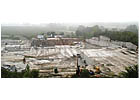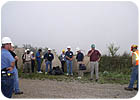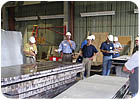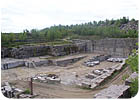
The Marble Institute of America (MIA) once again hit the road to tour some of the well-known quarries of North America. This time, the organization headed to Minnesota and South Dakota with a group of industry professionals who were eager to see various aspects of the quarrying and fabrication business in the Midwest. The two-day event, which was held from Thursday, August 23 to Friday, August 24, 2007, provided an educational experience as well as an opportunity for industry veterans and newcomers to network.
Local partners of the event included Cold Spring Granite Co. of Cold Spring, MN; Dakota Granite of Milbank, SD; Granite City Tool Co. of Waite Park, MN; and Komo Machine, Inc. of Sauk Rapids, MN. Additionally, MIA strategic partners included Alpha Professional Tools® of Oakland, NJ; Aqua Mix Inc. of Corona, CA; GranQuartz of Tucker, GA; Marmo Machinery USA of Southfield, MI; OHM International of Greensboro, NC; Park Industries of St. Cloud, MN; Vic International Corp. of Knoxville, TN; and Water Treatment Technologies of Hampton, NH.

Rockville White granite
On the first day of the tour, the group set out for Cold Spring Granite’s Rockville White quarry in Rockville, MN. The site is one of more than 30 quarries in North America owned by the company.When driving through the small town of Rockville, it becomes obvious that granite plays a significant part of the community’s history. The material adorns local architecture, including the Town Hall building.
While the quarry has been active since the early 1960s, Cold Spring Granite Co. has been operating the site since 1972. It sits on approximately 4 to 5 acres, and the stone runs between 6 to 11 miles deep. About 50% of the material quarried is used for markers with bronze plaques, and the other half is used for mausoleums, monuments and block sales.
Quarry Manager Tim Gross explained to the group that the Rockville Granite quarry is budgeted to produce 350,000 cubic feet of stone per year - about 24 to 34 blocks a week. And the company reports that it has about 45% yield.
Currently, there are six quarry workers at the site, but Gross explained how workers are rotated to Cold Spring’s various quarries as needed. “Years ago when I started, we had about 18 guys and only produced 100,000 cubic feet a year with 25% yield,” said the quarry manager. “Now we can do better with a small group of workers.”
Gross went on to explain that none of the granite that is extracted is left as waste. “For the past eight years, everything gets used for something,” he said. The quarry manager also said that Cold Spring does not blast too much anymore to remove granite blocks.
“Everything is hand wedged,” said Gross. “It’s a lot more quiet now. [Also] smaller blasts are less damaging to the stone, and safer.”

Visiting with Dakota Granite
After observing the quarrying operation in Rockville, the group was back on the bus and bound for South Dakota. Participants were greeted at Dakota Granite’s facility in Milbank with a welcome lunch before having the opportunity to visit the company’s Sunset Mahogany quarry and tour its stone-processing plant.Dakota Granite, which was incorporated in June of 1925 as a wholesale quarrier/fabricator of Dakota Mahogany monuments, employs approximately 85 workers and operates five quarries - four in South Dakota and one in Bellingham, MN. A total of 60% of its stone is used for monuments, while the other 40% consists of blocks that are exported to countries around the world, according to Rick Dilts, Vice President of Sales and Marketing.
Located adjacent to Dakota Granite’s office and processing plant, the Sunset Mahogany quarry is the company’s largest site. Originally started in the 1960s and expanded in the 1980s, the quarry runs about 200 feet deep. While some of the granite is used for block sales, Sunset Mahogany is primarily used for constructing monuments and mausoleums.
“The Sunset [quarry] is as deep as 15 miles,” said Dilts. “The problem with going deeper is the pressure down there. You see stones popping out like popcorn.”
Dilts went on to say that Dakota Granite had used derricks in conjunction with drilling and blasting to quarry granite, but now it has converted to wire saws. “It gives us a lot more flexibility with our block sizes,” he said.
Chuck Monson, company president, also joined the tour and explained the reclamation process. Although Dakota Granite’s facility sits on the prairies of South Dakota, a mountain range is visible in the distance. “It is manmade of waste,” said Monson. “The state comes once a year and gives us suggestions. We spend a great deal of time making it look natural.”
In addition to viewing the quarry, participants were led on a guided tour through the company’s processing plant. In one area that is designated to fabricating mausoleums, they had the opportunity to see large block cutters and wire saws in action.

Quarrying Carnelian granite
Before leaving South Dakota, the bus stopped at Cold Spring Granite’s Milbank quarrying area, which includes three sites. In particular, the group was shown the Carnelian #3 quarry - sprawling about 600 feet wide and between 1,800 and 2,400 feet long. A total of 60% of the material extracted from the quarry is used for structural building, while another 10 to 12% consists of blocks that are sold overseas.Cold Spring Granite Co.’s president, John Mattke, and Quarry Manager Steve Karels welcomed the group, and they provided some information on Cold Spring’s Milbank operation. In total, there are 52 workers between the three quarries, which operate year-round and share equipment.
According to Karels, the Carnelian #3 quarry produces about 125,000 cubic feet annually. A typical size block that is shipped to Cold Spring’s fabrication facility in Minnesota measures approximately 280 cubic feet or 50,000 pounds, as opposed to blocks weighing 4,200 to 4,500 that are shipped overseas.
At the time of Stone World’s visit, Cold Spring was operating two shifts at the Milbank quarries - an 8-hour morning shift, five days a week and a 10-hour night shift, four days a week. “At times that we are really busy, we quarry 24 hours a day, six days a week,” said Karels. “This quarry probably has a life expectancy of another 35 to 40 years.”

Emerging technology
Once back in Minnesota, the event’s first day concluded with a visit to the manufacturing facility of Komo Machine, Inc. in Sauk Rapids, MN. Started in 1966 by William Koska and George Molus in St. Cloud, MN, the two men were seasoned machinists and engineers who began the operation as a general metalworking business, producing a variety of manual and automated production line machines for major manufacturers of consumer appliances. Today, the company has expanded to a 175,000-square-foot plant in Sauk Rapids, and it produces machinery for stone fabrication.The group was welcomed to the facility with food and drinks, and then participants toured Komo’s facility. A live demonstration was given of the company’s Summit CNC Stone Machining Center. Komo’s staff was on hand to give details about the machinery as well as to answer any questions.
An exploration of stone working technology also took place the next day, when the tour reconvened at the hotel in St. Cloud, MN. Jeff Goodsell of Park Industries presented “Emerging Software within the Stone Industry.” Over breakfast, tour participants gained insight into the evolving technology of stone fabrication as well as having an opportunity to socialize with each other.
The group then headed out to visit Granite City Tool’s distribution center in Waite Park, MN. The company has been a manufacturer and distributor of diamond tools and manufacturing equipment for the stone industry since 1885, and it is now in its third generation of same-family ownership. In addition to its headquarters in Minnesota, Granite City Tool has distribution centers in the Northeast and centers in the West opening soon. Those on the tour were able to browse the store’s aisles and speak with company representatives about the products on display.

Gaining insight into stone fabrication
The bulk of the second day was spent visiting area fabrication shops, including StoneCrafters, Inc. of Saint Cloud, MN. The company, which was started in 1969, is owned and operated by Vern Salzl and his sons, Kurt and Dean.Group participants were welcomed in StoneCrafters’ showroom, and then were given the opportunity to tour the company’s fabrication shop. Kurt Salzl explained that while StoneCrafters produces about 10 kitchens a week, half of the company’s production is stone tabletops. It fabricates between 100 to 150 tabletops a week, which are distributed to dealers across the U.S.
“Our tabletops are growing by the minute,” said Kurt Salzl. “We can hardly keep up with it. They have done very well for us.”
Once the tour of StoneCrafters’ facility was complete, the group headed down the road to Granite Tops in Cold Spring, MN, where they were met by Kip Cameron, company owner. In addition to its 29,000-square-foot fabrication shop, which is equipped with an extensive line of machinery from Park Industries, Granite Tops also manages a high-end showroom. Also, the company opened a 24,000-square-foot facility two years ago in Albertville, MN.
“I am an accountant by trade,” Cameron explained to the group. “I started Granite Tops 13 years ago. Our main focus is strictly interior - mostly countertops.”
Granite Tops cuts between 34 to 50 slabs a day, according to Cameron. “Through the years, the CNCs have really brought our business to another level,” he said. In total, the company includes 100 employees and maintains about 2,500 slabs in inventory.
The last fabricator visit on the tour was at Northwestern Marble & Granite Co. in Minneapolis, MN. Company president David Grambling welcomed the group into its 20,000-square-foot shop and 7,000-square-foot office/showroom. He explained that the company’s production includes kitchens, commercial work and condominium remodels.
“We try to keep it even across the board, so if something is down, we can turn to something else,” said Grambling, adding that Northwestern Marble & Granite Co. processes about five kitchens a week. A total of 90% of the company’s products is made from natural stone, while the rest is Caesarstone and Dupont Zodiaq®. “About 70% of what we have we bring in from overseas,” said Grambling.

Viewing stone products
The tour also stopped in Maple Grove, MN, at one of Cold Spring Granite Co.’s three granite selection centers. Christine Hazen of Cold Spring Granite Co. greeted the group and explained that although the company does not sell directly to the public, the granite selection centers provide a place for homeowners, builders and fabricators to view slabs. The Maple Grove location includes three full-time and three part-time employees as well as two warehouse workers.In addition to opening its facility to group participants to view its showroom and inventory of slabs in its warehouse, Cold Spring Granite Co. also hosted a lunch for its visitors. Following this, Fred Jackson, CTC, CSI, of Estudio Group LLC in Anaheim, CA, presented a seminar entitled “Geology 301: From the earth to your showroom applying geology for increased sales.” The group attentively listened as Jackson explained the different minerals that are found in various stone. He also passed around samples of the actual minerals.
In response to the positive feed back of the MIA tours, another trip is being planned for next spring to a destination not yet announced. For a complete list of the MIA’s calendar of events, visit www.marble-institute.com
